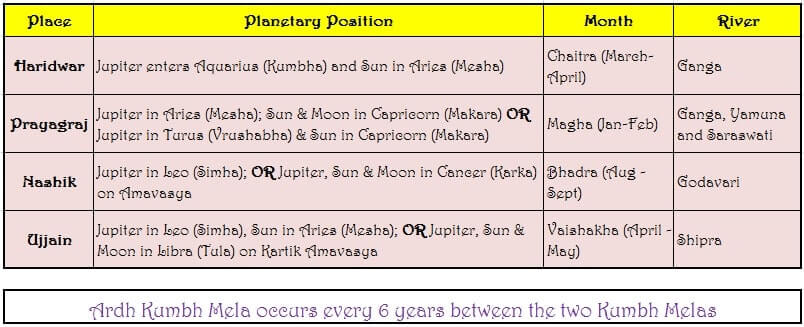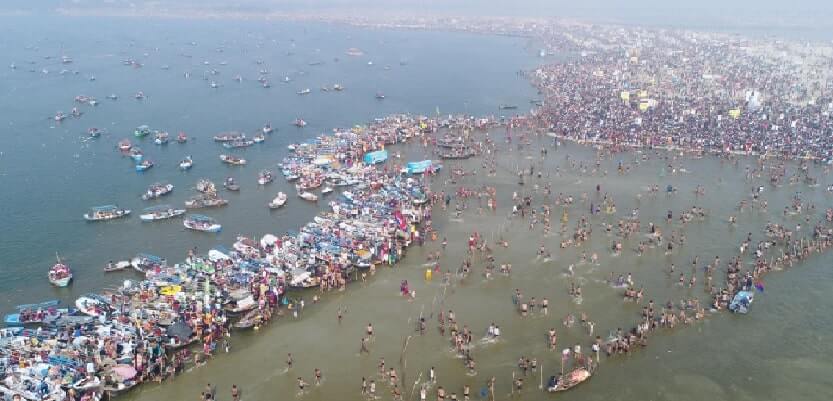Kumbha Mela is a largest Hindu pilgrimage gathering and a collective act of faith. It is an event or festival stretching for about 2 months, which spiritually unites people from all walks of life of India and across the world. Mela draws millions of pilgrims to bathe in the holy river. Bathing in these sacred rivers during Kumbh Mela is believed to wash away the sins of a person and takes closer to the Moksha (ultimate liberation). The biggest congregation includes Sadhus, Sadhvis, Saints, Ascetics, Kalpvasis, and Pilgrims. It is considered as the world’s largest congregation of pilgrims. It is also regarded as the largest peaceful gathering because nowhere in the world, such a large gathering assembled in such a peaceful manner. Kumbh Mela has been recognized by UNESCO as a cultural heritage.
Kumbh Mela is an event which is based on astronomy, astrology, traditions, belief, practices, and spirituality. Attendees of Kumbh Mela are from different sections of the society, ranging from Saints and Naga Sadhus, who follow a strict spiritual discipline; to Hermits, who leave their isolation only for these events; to seekers and disciples and to other practicing Hindus.
Activities during Kumbh Mela
Kumbh Mela is a festival of devotion, asceticism, faith, and wisdom. We can see a religious atmosphere everywhere and people of every walk of life will participate in religious fervor. It is also an occasion for devotees and pilgrims to have an interaction with Sadhus and Saints. It is a place, where people with different faiths & beliefs come together with the same objective. The common sight during Kumbh Mela includes people gathering to take a dip in the holy river, sadhus chanting prayers and mantras, Vedic yagyas (religious sacrifice), teachings of saints & sages, and dancing babas.
Types of Kumbh Melas
Ardha Kumbh Mela (Half Kumbh Mela)
Ardh Kumbh Mela happens six years after the Kumbh or Purna Kumbh Mela. However, Ardh Kumbh is observed only in Haridwar and Prayagraj.Kumbh Mela or Purna Kumbh Mela
It occurs every twelve years at a given place.Maha Kumbh Mela
It happens once every 144 years, which is after completion of 12 Purna Kumbh Melas. Maha Kumbh happens only in Prayagraj and not in other places.
Mythological Significance
Kumbh Mela has derived its name from two different perspectives. One is associated with an astrological sign called Kumbha (Aquarius) and another is associated with the ‘Kumbha’ (a pot), from which few drops of Amrit (or nectar of immortality) fell on earth.
It is believed that, after Samudra Manthan (churning of the ocean), Gods and Asuras (demons) fought for the Amrit. However, to prevent the demons from taking control of the nectar, Lord Vishnu, in the form of Mohini, whisked the pot (Kumbh) containing the nectar. It is said that the celestial bird Garuda was carrying Amrit to heaven and accidentally spilled a few drops at four places on earth, where the Kumbh Mela is celebrated. The four places are Haridwar (Brahmakund), Ujjain, Nashik, and Prayag. It is believed that it took twelve divine days which is equivalent to twelve human years for Garuda to carry the nectar to heaven. Therefore, the Kumbh Mela is celebrated once in every twelve years at a given place.
Astrological Significance
As per the mythological story, we have seen that it took 12 human years (12 divine days) for the celestial bird Garuda to carry the Amrit to heaven. In Astrology, Jupiter or Guru symbolizes divine power and is called Devaguru (Guru for Devas). It takes twelve years for Jupiter to complete one cycle of the zodiac (or one circle around the Sun in the solar system). Kumbh Mela is celebrated based on the special combination of positions of Jupiter, the Sun, and the Moon in the Zodiac. Whenever the three planets move in a particular pattern, that time is considered to be the holiest and the Kumbh Mela is celebrated in different places.
According to the astrological calculation, the Kumbh Mela takes place in different positions.

Location of Kumbh Mela
Kumbh Mela is celebrated four times in four different places over a twelve years period. Traditionally, four places in India are widely recognized to organize the Kumbh Melas and Mela site keeps rotating between one of the four places on a holy river in a twelve-year period. The four pilgrimage places are Haridwar, Prayagraj (earlier Allahabad), Nashik, and Ujjain. The Melas are held in one of the places according to celestial movements. The main festival sites are located on the banks of rivers as follows:
- Haridwar - on the river Ganga in Uttarakhand
- Prayagraj - at the sacred confluence of the Ganga, the Yamuna and the mystical Saraswati in Uttar Pradesh
- Nashik - on the Godavari river in Maharashtra
- Ujjain - on the Shipra river in Madhya Pradesh
At any given place, Mela is held every 12 years. Kumbh Mela festival starts from Haridwar. The Prayag Kumbh will be celebrated after 3 years of Haridwar Kumbh; the Nashik festival will be celebrated after 2 or 3 years of Prayag. But Kumbh Melas of Nasik and Ujjain are celebrated within the same year or one year apart.
